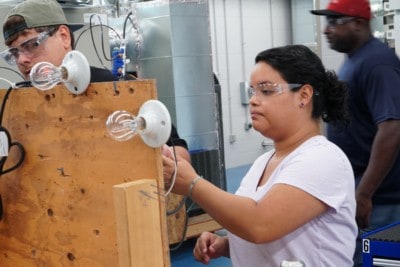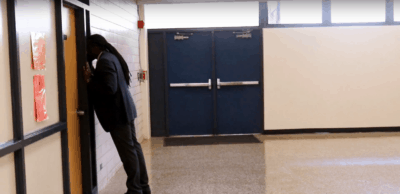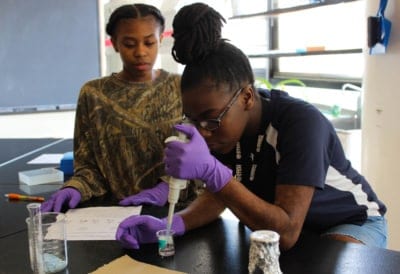This is an excerpt from “E(race)ing Inequities: The State of Racial Equity in North Carolina Public Schools” by the Center for Racial Equity in Education (CREED). Go here to read the full report and to find all content related to the report, including the companion report Deep Rooted.
The post-graduation occupational and educational ambitions of high school students are influenced by numerous personal and contextual factors (NCES, 2018; Frost, 2007). Students’ often cite “family” and “myself” as the most influential factors in their thinking about college and career (NCES, 2018). Studies also indicate that students’ perceptions of their own ability, the barriers they may face, and a sense of belonging in college or the workplace also affect postsecondary aspirations (Fouad & Byers-Winston, 2005; Horvat, 1997; Nora, 2004). Naturally, social context (family, community, school, etc.) play a role in students’ perceptions of themselves and their place in the world. Broad forces like labor market conditions, residential segregation, and both real and perceived levels of discrimination in college admissions, campus life, and hiring practices also appear to influence aspirations (Fouad & Byers-Winston, 2005; Frost, 2007; Meyer, 1970).
Schools occupy an important position in the development of students’ college and career intentions (NCES, 2018). The expectations of school staff, counseling behavior, the racial makeup of schools, and levels of school racial/class segregation have long been recognized as mediators of students’ thinking and beliefs about college and career (Frost, 2007; Meyer, 1970). Research has also demonstrated how postsecondary intentions and the mix of factors that influence those intentions differ by race, ethnicity, and social class. Students of color, particularly Black and Hispanic students, appear to have different perceptions of their college and career options than wealthier, Whiter populations (Fouad & Byers-Winston, 2005). After all, they face the prospect of entering college environments and/or a labor market in which there is real and perceived racial and socioeconomic discrimination, and where people of their shared racial/ethnic group are concentrated in less elite institutions and lower level, unskilled occupations (Fouad & Byers-Winston, 2005; Bureau of Labor Statistics, 2019). These factors, in turn, affect the sense of belonging students of color feel when considering college and career choices (Frost, 2007; Horvat, 1997; Hurtado & Carter, 1996).
North Carolina high schools collect data on the intentions of graduates and report that data to the North Carolina Department of Public Instruction. These data represent students’ self-reported postsecondary intentions, so they may not be indicative of students’ actual trajectories after graduation. Graduates are asked to indicate if they intend to pursue enrollment in four-year college, two-year college, junior college, trade/business/nursing school, or community/technical college. Graduates may also indicate intentions to join the military, pursue employment, or some “other” option(s) after completing high school. State agencies do not collect data on what students actually do after high school, nor are intentions linked to actual choices in any meaningful way.
Methodology
For the purposes of this report, we examine postsecondary intentions primarily as an indicator of access and opportunity because schools play such an important role in students’ college and career perceptions, access to college-preparatory coursework, relationship to counseling, and the real/perceived postsecondary expectations of teachers and other school staff. Our analytical approach focused on college-bound versus non-college-bound intentions based on the well-researched link between college attendance and future income, social status, and career-related behavior. In the sections that follow, we analyze data from approximately 104,000 public high school graduates in 2016-2017. We report on college versus non-college intentions and the specific intentions of graduates based on racial/ethnic group. We also assess how race/ethnicity and a number of other relevant factors are related to the decision to pursue college.
Analysis
Figure 13.1 presents the percentage of graduates with college-bound intentions and those with four-year college intentions by race/ethnicity. For data on all students’ postsecondary intentions, see Appendix A, Table 6.
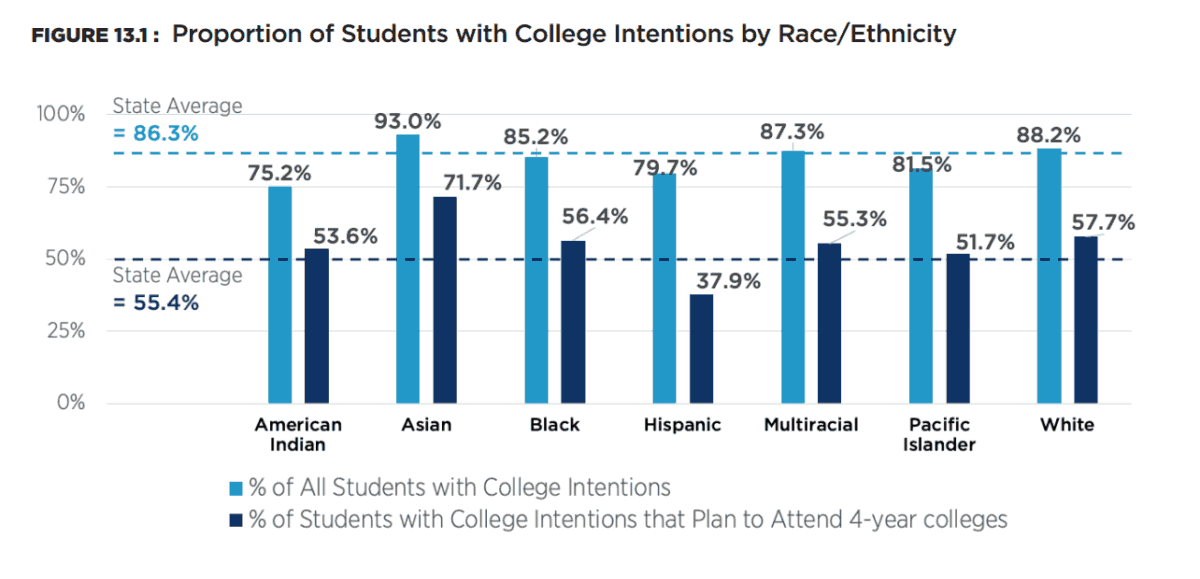
Asian, White, and Multiracial students report the highest average rates of college-bound intentions and do so at rates above the statewide average (86.3%). American Indian, Black, Hispanic, and Pacific Islander students intend to enroll in college at rates below the statewide average. American Indian (75.2%) and Hispanic students (79.7%) intend to enroll in college at the lowest rates.
Among graduates that plan to enroll in four-year colleges, Asian, Black, and White students are above the statewide average (55.4%), while American Indian, Hispanic, Multiracial, and Pacific Islander students fall below the average for all graduates. The percentage of Hispanic students aspiring to four-year colleges is remarkably low relative to other racial/ethnic groups. Were they to match the current statewide average, an additional 860 Hispanic students would aspire to college, and over 2000 more Hispanic students would aspire to attend four-year colleges.
We also built models to predict the likelihood that students from different racial groups would have college-bound intentions. Model 1 represents the likelihood of a student from each racial/ethnic group to report college-bound intentions as compared to White students based on race/ethnicity alone. Model 2 shows the likelihood based on race/ethnicity while controlling for gender, free/reduced lunch status, language status, special education status, and giftedness. Figure 13.2 presents the results of the prediction model.
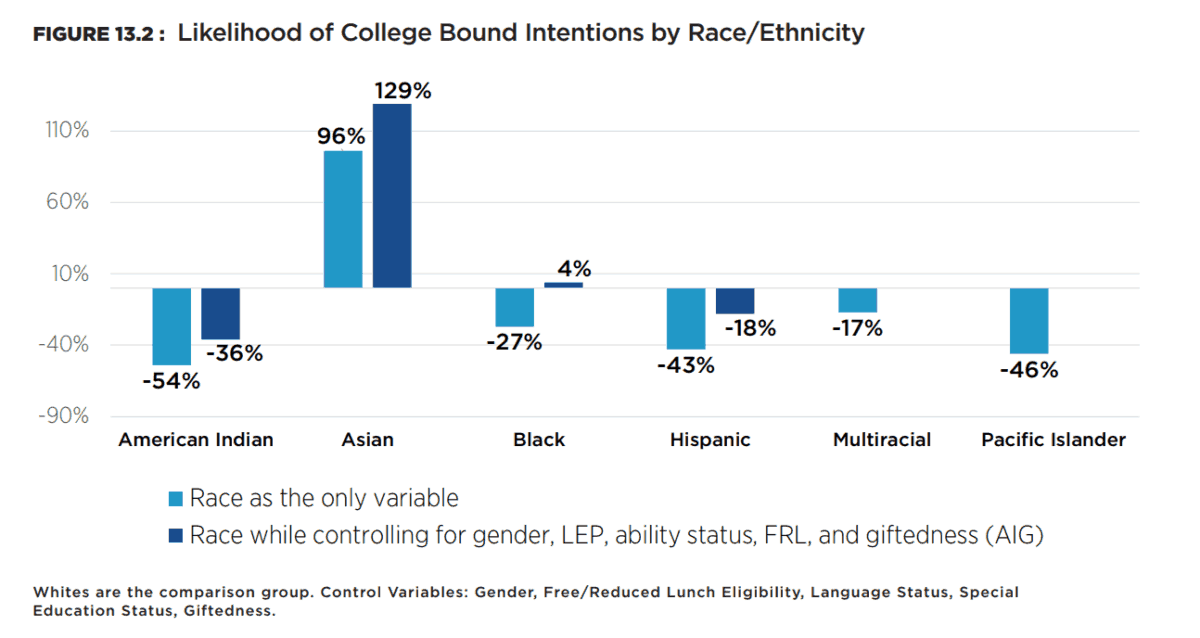
While controlling for other factors, Asians have dramatically higher odds of having college intentions than their White counterparts. Black students were 4% more likely to aspire to college than Whites net of other factors in the model. American Indian (-36%) and Hispanic (-18%) students were predicted to have substantially lower likelihoods of college intentions even while controlling for other variables. The college intentions of Multiracial and Pacific Islander students were similar to those of White students when controls were applied.
Takeaways
The analysis presented here supports previous literature in the finding that race/ethnicity is an important factor in the college and career aspirations of high school graduates (Fouad & Byers-Winston, 2005; Frost, 2007; Nora, 2004). We found differences among North Carolina public high school graduates in 2016-2017 of different races/ethnicities with regard to intentions to enroll in college, the proportion of college aspirants who planned to enroll in four-year colleges, and in the likelihood that student groups of color would intend to enroll in college after graduation as compared to White students after controlling for other potentially relevant factors.
Results were particularly concerning for American Indian and Hispanic students who consistently showed large differences from other groups across our different analyses. Controlling for Hispanic students’ over-representation among Limited English Proficient populations appears to attenuate (but not erase) the difference between the college intentions of Hispanic and White students. When considered alongside high school dropout data presented elsewhere in this report, analyses raise serious questions about the ability of North Carolina public schools to produce college-ready, college-aspiring Hispanic students. The situation appears to be even worse for American Indian students, who remain far less likely than Whites to aspire to college. Overall, the results suggest that American Indian and Hispanic students may lack the structural supports (i.e. academic expectations, counseling behavior, access to college-preparatory curricula) afforded to other racial ethnic groups.
Results for Black students were noteworthy as well. While fewer Black students in aggregate reported plans to enroll in college (including four-year college) as compared to their White counterparts, the relationship inverted when we controlled for other relevant factors, such that Black students were 4% more likely than Whites to aspire to college. Thus, even though Black students appear to aspire to college at rates higher than similarly situated White students, our results suggest that their over-representation among lower income and special education populations and under-representation in gifted programs may constrain the ability of Black students from realizing their postsecondary intentions.
Overall, our analysis is consistent with previous literature that emphasizes how the college and career challenges faced by non-Asian students of color are different than those faced by White and Asian students. We view the processes that contribute positively to students’ postsecondary intentions as a part of explicitly stated goals of North Carolina public schools around college and career readiness. Research suggests that culturally appropriate college and career counseling, which incorporates the sociopolitical context within which students of color work and live, has a better chance of addressing the unique needs of students of color (Fouad & Bingham, 1995; Nora, 2004). While our analysis captures the variation in students’ intentions, the absence of complementary data on outcomes makes it difficult to fully appreciate the effect that differences in postsecondary intentions might have on the future of students from disparate racial/ethnic backgrounds.
References
Bureau of Labor Statistics. (2019). Employed persons by detailed occupation, sex, race, and Hispanic or Latino ethnicity. Washington, DC: Bureau of Labor Statistics. Retrieved from https://www.bls.gov/cps/cpsaat11.htm.
Fouad, N. A., & Byars‐Winston, A. M. (2005). Cultural context of career choice: meta‐analysis of race/ethnicity differences. The Career Development Quarterly, 53(3), 223-233.
Frost, B. F. (2007). Texas students’ college expectations: Does high school racial composition matter?. Sociology of Education, 80(1), 43-65.
Horvat, E. M. (1997, March). Structure, standpoint and practices: The construction and meaning of the boundaries of blackness for African American female high school seniors in the college choice process. Paper presented at the Annual Meeting of the American Educational Research Association, Chicago.
Hurtado, S., & Carter, D. F. (1996). Latino students’ sense of belonging in the college community: Rethinking the concept of integration on campus. In F. K. Stage, G. L. Anaya, J. P. Bean, D. Hossler, & G. D. Kuh (Eds.), College students: The evolving nature of research (pp. 123-136). Needham Heights, MA: Simon & Schuster.
Meyer, J. W. (1970). High school effects on college intentions. American Journal of Sociology, 76(1), 59-70.
National Center for Education Statistics. (2018). High school students’ views on who influences their thinking about education and careers. Washington, D.C.: National Center for Education Statistics.
Nora, A. (2004). The role of habitus and cultural capital in choosing a college, transitioning from high school to higher education, and persisting in college among minority and nonminority students. Journal of Hispanic higher education, 3(2), 180-208.
Editor’s note: James Ford is on contract with the N.C. Center for Public Policy Research from 2017-2020 while he leads this statewide study of equity in our schools. Center staff is supporting Ford’s leadership of the study, conducted an independent verification of the data, and edited the reports.
Recommended reading
